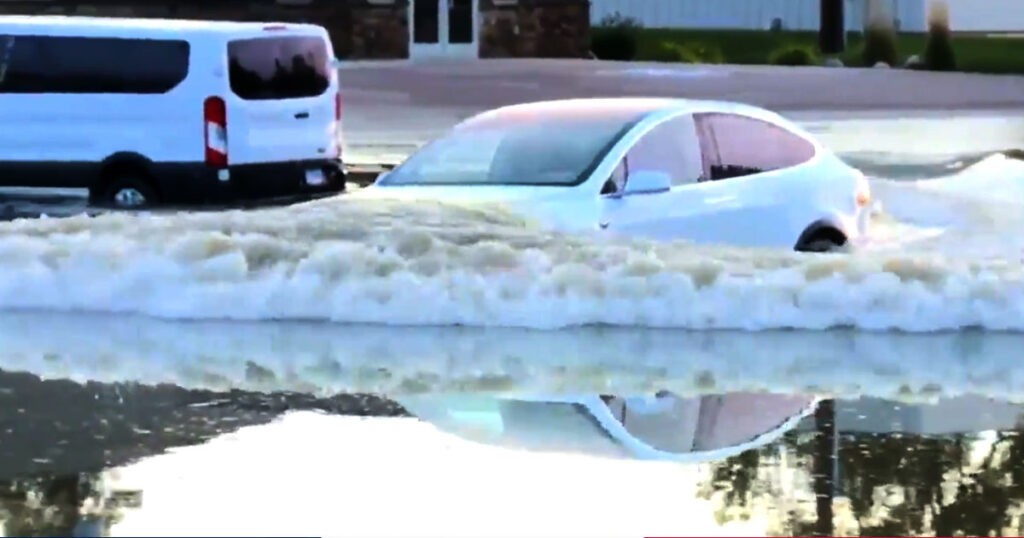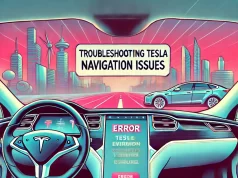In this article, we will examine how Tesla vehicles cope with water in different situations and what are the risks and benefits of driving a Tesla in wet conditions.
What Happens If Tesla Goes in Water?

Tesla vehicles have some features that make them more water-resistant than conventional cars. Here are some of the things that can happen if a Tesla goes in water:
1. If the water level is low, such as in a puddle or a flooded road, Tesla vehicles can wade through it better than gas-powered cars.
This is because Tesla vehicles do not have air intake or exhaust pipes that can choke in water. The electric motors and battery pack are sealed and encased on the cabin floor, preventing water from getting inside them.
2. If the water level is high, such as in a deep pool or a river, Tesla vehicles can float on water for a short time and use their wheel rotation for propulsion.
This is called the boat mode, which was revealed by Elon Musk on Twitter in 2016.
However, this mode is not recommended and does not cover the warranty. The vehicle can also overturn or hit something underwater, causing the battery system to break and seal itself.
3. If the vehicle is submerged in water, such as in a lake or an ocean, Tesla vehicles can act as a lifeboat and keep the occupants safe.
This is because Tesla vehicles are well-sealed and do not have any openings that can let water in.
The electric motors can also continue to produce power in the water. However, this situation is very dangerous and should be avoided at all costs.
The vehicle can also suffer from corrosion, mold, fire hazards, and electrocution risks if water gets into the modules or the battery pack.
Tesla’s Boat Mode: A Fun but Risky Feature
One of the most interesting features that Tesla has added to its Model S is the boat mode.
This mode allows the Model S to float on water for a short time and use its wheel rotation for propulsion.
This feature was revealed by Elon Musk on Twitter in 2016 after a video of a Model S driving through a flooded tunnel in Kazakhstan went viral.
However, Musk also warned that this mode is not recommended and that Tesla’s warranty does not cover water damage. Therefore, this mode should be used only as a last resort in case of emergency.
Tesla’s Safety in Water: Better than Average but Not Foolproof
Tesla vehicles are generally safe in contact with water, as long as they are not submerged or exposed for a long time.
The electric motors and battery pack are well-protected from water ingress and do not pose any risk of electrocution. The seals on the doors, windows, hood and trunk are also effective in keeping water out of the cabin while driving through shallow water.
However, Tesla vehicles are not waterproof and can suffer damage if they are flooded or driven in deep water.
Therefore, Tesla owners should avoid driving their vehicles in such conditions and follow the local regulations and warnings regarding water hazards.
How deep of water can a Tesla drive through?
Tesla Wading Depth (Model 3, S, X, Y)
According to some web sources, the Tesla Model 3 has a wading ability of about 18 inches to 2 feet of water.
However, this is not officially recommended by Tesla, and driving through deep water may cause damage to the car’s electrical system, undertray, or drive units.
The battery pack is supposedly sealed and unaffected by immersion, but high-velocity spray or pressure may still pose a risk.
Therefore, it is advisable to avoid driving through water whose depth is unknown or too high and to proceed with caution and low speed if necessary.
There have been some cases of Tesla Model 3 owners driving through flooded roads or even floating across water, but these are not indicative of the car’s versatility or reliability in such conditions.
Tesla’s Electric Motors and Battery Pack: Sealed and Safe
One of the main advantages of Tesla vehicles over conventional gas-powered cars is that they do not have engines.
Instead, they have electric motors that power the wheels. These motors are sealed and encased in the cabin floor, along with the battery pack.
This means that they do not have air intake or exhaust pipes that can choke in water.
Therefore, Tesla vehicles can wade through water better than regular cars, as long as the water level does not reach the cabin.
Tesla’s Doors, Windows, Hood, and Trunk: Good but Not Perfect
Another factor that affects Tesla’s water resistance is how well its doors, windows, hood, and trunk are sealed.
According to Tesla’s warranty document, the company does not cover damages from a flood or driving in deep water. This implies that Tesla vehicles are not designed to be fully submerged in water.
However, some videos have shown that Tesla vehicles can drive through water that comes up to their wheels without any problem.
This suggests that Tesla vehicles have good seals that prevent water from getting inside the cabin while driving through shallow water.
Conclusion
Tesla is one of the most advanced electric vehicle brands in the world, but it is not flood proof.
Tesla vehicles can handle water better than conventional cars, but they are not designed to be submerged or driven in deep water.
Tesla owners should be careful when driving their vehicles in wet conditions and use the boat mode only as a last resort.
Tesla vehicles are waterproof for a short time, but they are not amphibious.




